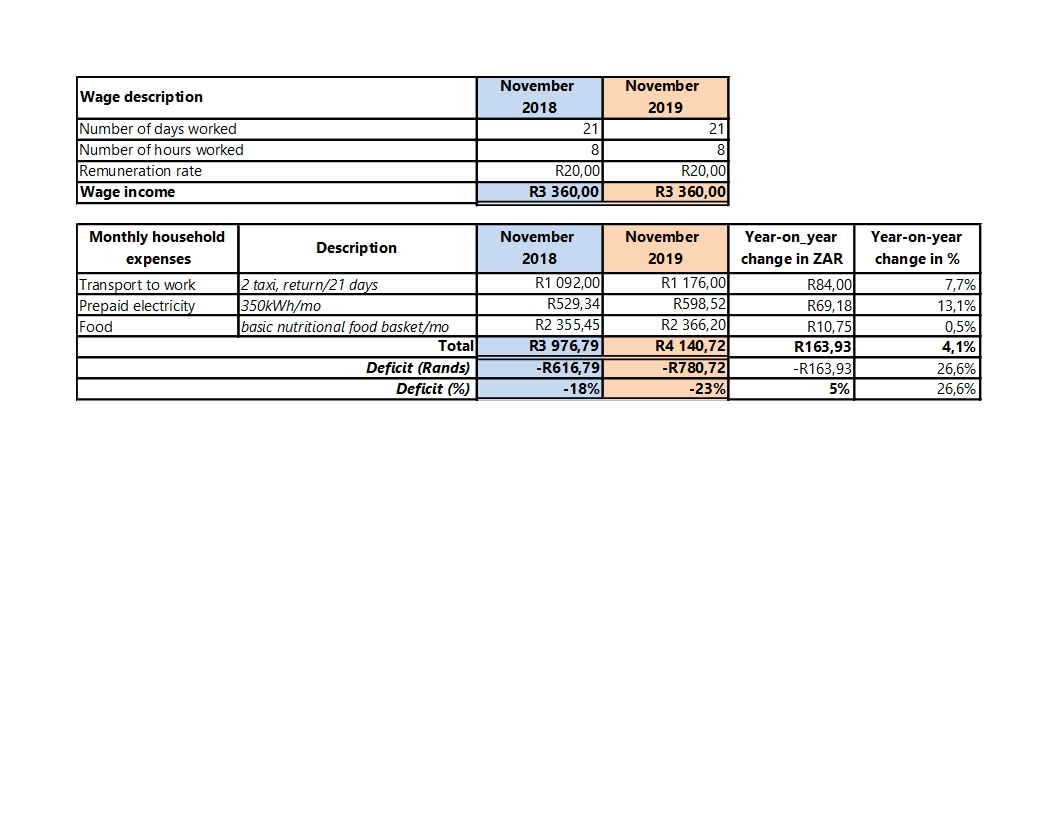Deficit in the National Minimum Wage widens by 5% year-on-year.
We are close to marking one year since the introduction of the National Minimum Wage. The value at which the NMW is set will be reviewed.
Workers work to support their families. Workers reasonably expect that their wages will cover the real costs of several core basic goods and services.
To be productive in the workplace, workers need to secure basic goods and services for their families. These goods and services need to be paid for out of the wages earned by the worker.
The National Minimum Wage, when first conceived had the wage level set at R3 500 a month or R20 an hour. At the time we argued that at this level the NMW was a poverty wage.
The National Minimum Wage came into effect on the 1st of January 2019. An hourly and not a monthly rate was legislated, and differential rates were set for different categories of workers. The hourly rate was set at R20 for general workers, R18 for farmworkers and R15 for domestic workers. A 10% reduction of the NMW was subsequently introduced via an exemption process reducing the wages of general workers to R18 an hour, farmworkers to R16,20 an hour and domestic workers to R13,50 an hour.
Before the NMW was introduced we tracked the value of a hypothetical NMW against the real costs of several core basic goods and services that workers reasonably expected to cover. We are now able to show the deficit in the value of the NMW year-on-year in relation to the cost of three core goods and services out of a myriad of expenses which workers need to secure each month: transport to work and back, electricity and food.
In the graphic below we use the best wage scenario for a South African worker: being classified as a General Worker; earning the maximum NMW (R20) for the maximum hours (8), and maximum number of working days (21) in the month/s of November 2018 and 2019. The total NMW is R3 360.
Table 1: Year-on-year comparison of income (via the NMW) and 3 core expenditures to show the deficit in the NMW value in November 2019.
Between November 2018 and November 2019, the deficit in the NMW has increased by 5%, from a -18% deficit to a -23% deficit.
Table 1 shows:
(1) how inadequate the level of the NMW is as it is not enough even to cover the three core goods and services (transport, electricity and a basic nutritional food basket);
(2) how the escalation of basic goods and services year-on-year has reduced the buyer power of the NMW.
If a worker were to cover just the 3 core expenses in November 2019 then the NMW would have to be increased to R24,65 an hour and workers guaranteed the maximum working-day month. However even this increase is insufficient as families have more expenses then just transport fare to work, electricity and basic food. The gap between what the NMW is (this is the best case scenario, useful to remember) and what households require to be productive; to be healthy; to be vital; and create possibilities for their children’s lives to be better and to thrive; to invest and spend money to get the economy moving, is much greater than R24,65.
The level at which the NMW is set is important: a poverty level NMW cannot be an instrument that will help South Africa’s economy and social situation recover or move us into a new social and economic trajectory. A widening deficit of 5% in the NMW and the cost of goods and services year-on-year gives further evidence of a wage level that sees workers worse off this year than they were last year. We argued previously that by setting the NMW at a poverty level what we have done is to strap our feet to the back of our knees. The review of the National Minimum Wage level in the next few months may be an important chance to reimagine the wage in a much broader way – as an instrument for economic change, improved health and productivity and education outcomes, greater societal security and an improved trajectory for South Africa.
Regards.
For more information or media enquiries please contact Mervyn Abrahams on 079 398 9384 or at mervyn@pmbejd.org.za



